Magnolia vine
 Schisandra chinensis - Magnolia vine is a valuable climbing plant originating from China, Korea, and Siberia, grown for ornamental and medicinal purposes as well as for consumption. Its main attraction are bright red, round berries.
Schisandra chinensis - Magnolia vine is a valuable climbing plant originating from China, Korea, and Siberia, grown for ornamental and medicinal purposes as well as for consumption. Its main attraction are bright red, round berries.
Szczepan Marczyński
It has very attractive, elliptic or oval, pointed leaves. They are of a glossy deep green with red petioles. In autumn they turn yellow. Stems are brown and reach between 3 and 10 m (with 0.5 - 1.5 m of annual growth), either twining round the support or creeping along the ground.
 Schisandra chinensis (ph. Sz. Marczyński) |
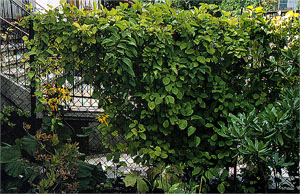 Schisandra chinensis (ph. Sz. Marczyński) |
Its main attraction, however, are bright red, round berries that appear in September, gathered in grape-like clusters. They contain schisandrine (tonifying and strengthening substance), vitamin E and easily assimilated microelements: iron, copper, manganese, nickel, molybdenum, titanium and zinc, as well as being high in magnesium, potassium, and phosphorus. Fruit can be eaten raw or processed e.g. it may be dried or made into juice, extract, infusion or liqueur. Schisandrine and other substances of medicinal properties are present also in bark, leaves and seeds. An invigorating and energizing infusion can be made from dried leaves. It is used to combat physical and mental fatigue, drowsiness, exhaustion, depression, anemia, lung, liver and digestive system diseases and poor visual acuity.
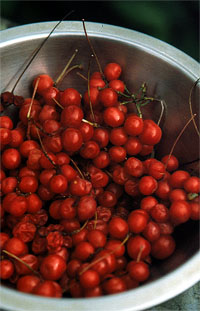 Schisandra chinensis - collected fruits (ph. Sz. Marczyński) |
It should not be used in case of nervous hyperactivity, insomnia, hypertension and heart diseases. In the Far East, besides ginseng, schisandra is the most popular herbal drugs. Its Chinese name 五味子 "wu-wei-zi", meaning five taste fruit, reflects an unusual combination of flavours, as the outer shell of the fruit is sweet, the flesh sour, the seeds bitter and tart, whereas magnolia vine's extract tend to be salty.
Magnolia vine is a monoecious plant, i.e. it has both male and female flowers on each individual plant, although sometimes you can encounter dioecious specimens (plants that bear either only male or female flowers). Small, white, creamy or pink blossoms appear at the end of May and the beginning of June. Berries ripen from mid August to mid September.
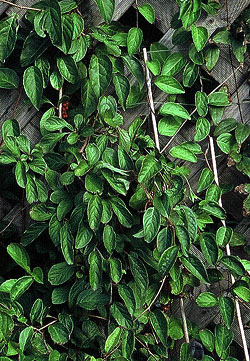 Schisandra chinensis on the wall (ph. Sz. Marczyński) Schisandra chinensis on the wall (ph. Sz. Marczyński) |
Schisandra is a frost hardy plant sustaining temperatures down to -30oC and sometimes even down to -40oC.
It can be grown up fences, walls, on pergolas and the special T-shaped supports, similarly to actinidias. It requires soil that is fertile and moist, but not damp. It performs best in well-lit positions, but without direct sun, so it's best to plant it on a sheltered site northern-west or northern-east aspect. Magnolia vine can be planted all year round. Put it carefully to a large pit, provide good drainage and lay the bottom with manure, analogically as when planting clematis. During the first 2-3 years it's best left to grow unrestrained. Afterwards you should choose between 1 and 3 the strongest stems and tie them up to a support to make them grow vertically. The stems that creep along the ground don't form bud flowers and consequently they don't bear fruit. Every year in early spring, before the beginning of a growing season prune the plants removing all weak and ill shoots and cut last year stems above the 12th-15th well developed bud. Remember to water regularly and abundantly as schisandra doesn't tolerate drought. Start fertilizing it in the second year after planting. A correctly trained plant will start bearing fruit in the fourth-sixth year after planting. One bush will yield from 1 to 5 kilos of berries.
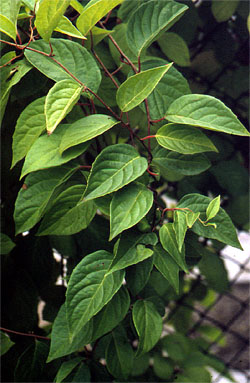 Schisandra chinensis - leaves (ph. Sz. Marczyński) | 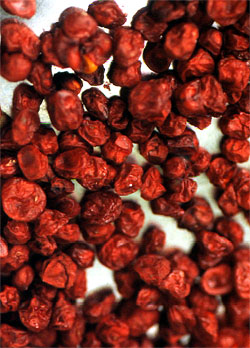 Schisandra chinensis - dried fruits (ph. Sz. Marczyński) |
